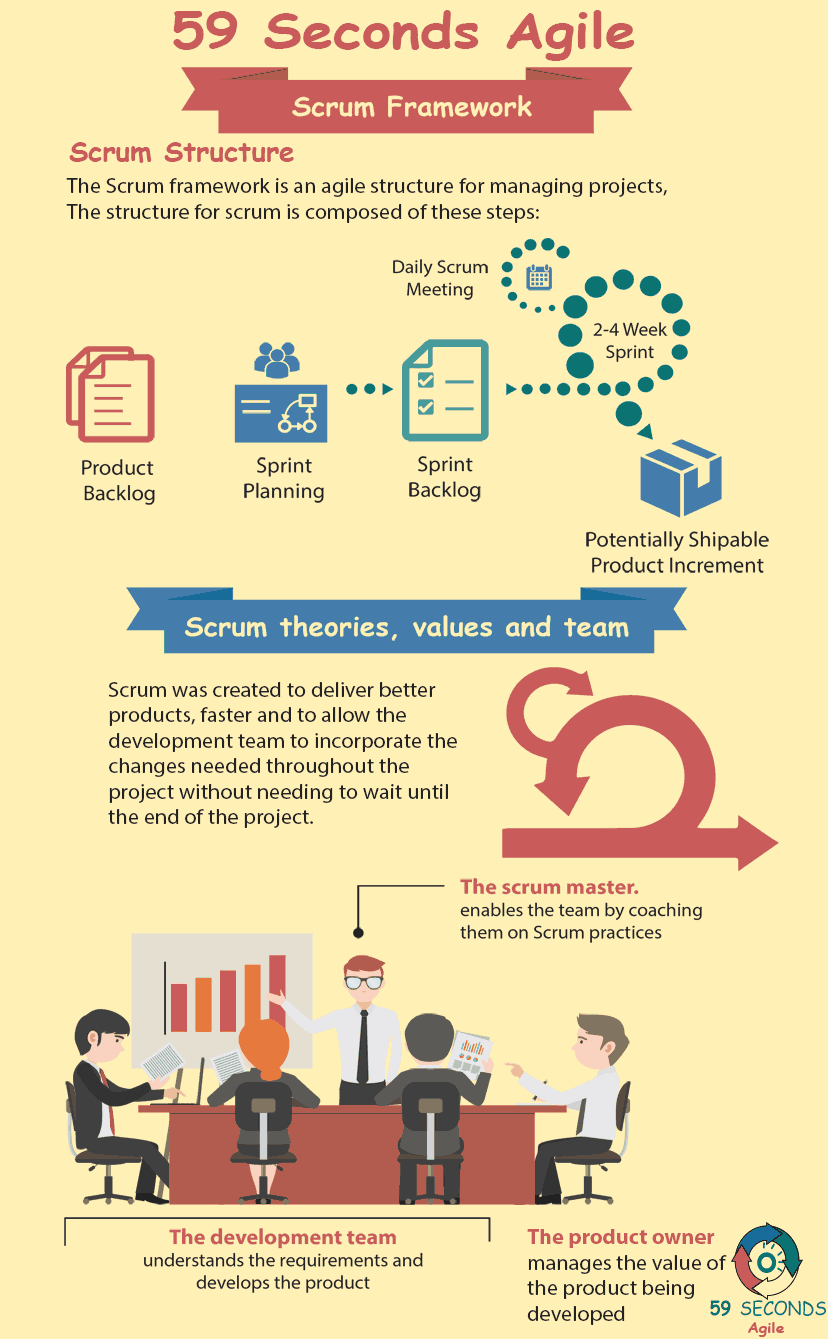
The Scrum Framework For Product Owners
Scrum Framework
When talking about the framework, we are talking about a way of doing things, a structure to organize work. The Scrum framework is an agile structure for managing projects, especially the complex ones. The structure for scrum is composed of these steps:
1. Create and prioritize the product backlog
2. Define the sprints sizes
3. Perform the Scrum events: Sprint, Sprint Planning, Daily Scrum Meeting, Sprint Review and Sprint Retrospective
Scrum theories, values and team
Scrum was created to deliver better products, faster and to allow the development team to incorporate the changes needed throughout the project without needing to wait until the end of the project. The work is gradually incremented by each sprint completion and since it’s iterative, it is easier to adapt to changes or solve problems down the road. Scrum believes in each person as being autonomous and capable of performing his/her job. What is great about Scrum is its capability of adapting, changing what is not going well, to improve for the future.
One of the values of Scrum is courage: meaning that the development has the courage to work on the project and deliver their work, even if it’s a complex task. The other one is the focus: by defining the product backlog and what is going to be done on each sprint, this allows the development team to focus on the work ahead and not get distracted by problems or other tasks which are not part of the sprint. The third value is commitment: each person within the development team will have their own tasks to complete and at the beginning of the sprint they, individually decide how many tasks they can deliver in that sprint. The fourth value is respect: each scrum member respects the other on completing their tasks. The last value is openness: all the team members are open about their tasks and also about the problems that they may encounter during the sprint.

The Scrum team is composed of Product Owner, Scrum Master, and development team. The Product Owner is the one responsible for defining the product backlog and is the voice of the customer to the scrum team. The Scrum Master is the facilitator, his main job is to keep the development team on track and help them to remove the roadblocks and impediments. The development team is everyone responsible for actually doing the tasks within the sprint, they deliver the work.
Scrum Events
The first scrum event to consider is the Sprint or iteration: that’s how the work is going to be divided and is the core of Scrum. Sprints are timeboxed periods of between one and six weeks in duration. The second event is the Sprint Planning: that’s a meeting where the scrum team organizes the work for the next sprint. In this planning, the team discusses which tasks are going to be completed and their weight, which means, the effort needed to complete each one of the tasks. It’s up to each development team member to decide which tasks can be done, Scrum allows for the self-organizing of the team, there is no need for someone deciding what the development team is going to do.
Our Favourite Agile Books
We found these books great for finding out more information on Agile Scrum:
The third event is the Daily Scrum Meeting: this is, as the name suggests, is a short daily meeting which involves the scrum team for a maximum of 15 minutes. The team discusses three points: what they did yesterday, what they are planning to do today and if they are facing any issues or impediments. This meeting is not the place to discuss further the tasks or problems, if there is a need for it, the development member should discuss with the Scrum Master after, so they can assist the developer in completing the task.
The fourth event is the Sprint Review: during the sprint review the development team demonstrates the sprint deliverables, and the product owner either accepts the work as done or rejects the work. Any rejected work or required modifications are then added to the product backlog and prioritized for future sprints.
The last event is the Sprint Retrospective: this event is the opportunity for the scrum team to evaluate the processes from the current sprint. Topics include: discuss what went well, what did not go well, and what can be improved? This discussion allows the team to better understand the problems they had and to improve for next sprint, as well as to appreciate what went well and continue doing it.
The Product Owner and Complex Projects
The Scrum framework is a structure that allows the management of complex projects in an easier way, by delivering pieces of work, by empowering the scrum team and by welcoming changes along the way. The Product Owner is the one who will create the product backlog and prioritize the tasks.

